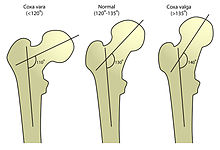Coxa valga
Medical condition
| Coxa valga | |
|---|---|
 | |
| Left to right: coxa vara, normal femur, coxa valga | |
| Specialty | Medical genetics |
Coxa valga is a deformity of the hip where the angle formed between the head and neck of the femur and its shaft is increased, usually above 135 degrees.
The differential diagnosis includes neuromuscular disorders (i.e. cerebral palsy, spinal dysraphism, poliomyelitis), skeletal dysplasias, and juvenile idiopathic arthritis.
Coxa valga deformity is a common pathologic condition in children with cerebral palsy and they may be predisposed to hip subluxation or dislocations.[1]
See also
- Coxa vara
- Genu valgum
- Genu varum
References
- ^ Hsieh, H. C.; Wang, T. M.; Kuo, K. N.; Huang, S. C.; Wu, K. W. (2019). "Guided Growth Improves Coxa Valga and Hip Subluxation in Children with Cerebral Palsy". Clinical Orthopaedics and Related Research. 477 (11): 2568–2576. doi:10.1097/CORR.0000000000000903. PMC 6903837. PMID 31425278.
External links
This article about a disease of musculoskeletal and connective tissue is a stub. You can help Wikipedia by expanding it. |
- v
- t
- e
 | This human musculoskeletal system article is a stub. You can help Wikipedia by expanding it. |
- v
- t
- e










